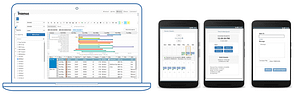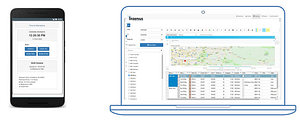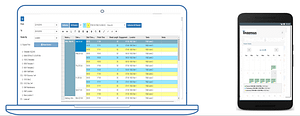Payroll Hiring Trends 2023
Article extracts from Andrew Brushfiled in HRM Online.
Internal promotions, hiring freezes and prioritising cybersecurity skills are among the eight key hiring trends that are set to shape the talent market in 2023.
As we ponder on what we will be facing in 2023 the idea of hiring the team we need to deliver our products and service may dominate our thoughts.
This requirement on top of the fear of recessionary impacts on our business create conflicts for action.
I believe the answer is to look to ways of getting more productivity for the same staff, particularly back-office functions like HR and Payroll. We should provide the tools for our team to simplify the process from hiring to payroll, #ThatsInzenius
Inzenius from Onboarding linked to Rostering all the way through to Payroll in one system delivers a potential 65% plus efficiency gain whilst improving payroll accuracy thorough its automated Award Interpretation from the system approved timesheets.
Inzenius payroll efficiency compared to the APA benchmark highlights the overall payroll productivity improvement of up to 65% and 30% overall cost savings potential.

The direct communication to and from the employee’s device improves employee satisfaction.
As employers continue to face ongoing skills shortages and a looming recession, the recruitment landscape in 2023 will be shaped by cost-cutting and upskilling measures to help businesses weather the storm.
Here are eight recruitment trends that HR should keep an eye out for in the new year.
- ‘Rightsizing’ versus downsizing
Talks of a potential recession have hit Australia’s shores, with growing employer concerns about the rate of hiring and turnover. Multinational corporations with offices in Australia will likely rein back their hiring plans and implement tentative hiring freezes, taking the lead from their UK/US headquarters.
At the same time, local businesses will focus on maintaining headcount and filling vacant roles rather than adding new positions. Companies that added permanent headcount in 2022, with some having over-hired or ‘panic hired’ during a time when business confidence and growth initiatives accelerated, are restructuring and focusing on optimising the team headcount and managing workloads.
Next year will likely see companies focus on efficiency and improving the productivity of existing employees.
- Increased use of contract talent
With more caution in the market, companies are less inclined to commit to permanent headcount, and want the flexibility to scale their workforce up and down as required.
As a result, 2023 will see employers increasingly engage contract talent to secure specialised skills immediately, with the flexibility to keep staff on for longer if required.
Contracting is already a common hiring strategy, with Robert Half’s June 2022 research of 300 hiring managers, CFOs and CIOs finding that almost seven in ten (68 per cent) companies in Australia are working with contract staff. This number is expected to grow going into 2023.
- Salary to drive candidate decisions
Pay remains a crucial factor at a time when candidates have substantial power to negotiate their salary. However, candidates need to be realistic around salary expectations. Business leaders are making every hire count, and the big money will only go to candidates with a wealth of experience and knowledge.
As cost-of-living pressures escalate, candidates will continue to follow the dollar sign to stay ahead of inflation. Even though the employment market is set to ease and some starting salaries are set to stabilise, ongoing skills shortages in specialised areas will continue to give jobseekers with in-demand skills and experience the bargaining power to demand a higher salary.
Regular salary benchmarking remains critical for employers to ensure they offer salaries in line with current market rates.
- Demands for workplace flexibility despite in-office employer requests
With lockdowns now becoming a thing of the past, more employers will request that employees increase their number of in-office days in 2023.
However, many candidates and employees will not consider a role that involves working in the office full-time, and will expect a high level of workplace flexibility. This will put those employers in a challenging situation when it comes to attracting and retaining staff.
The hyper-focus on work-life balance means employees will continue to expect flexible working arrangements. Companies that want employees back in the office need to strike a balance between in-person office days to build corporate culture and collaboration opportunities, while sustaining flexibility to uphold work-life balance and employee morale.
- Values-driven jobs selection
Candidates are taking a more values-driven approach to their career choices, especially Gen Z, tending only to consider organisations whose values align with their own.
When evaluating job opportunities, candidates are asking questions about a company’s ethical behaviour, corporate citizenship and diversity, equity and inclusion (DEI) and environment and social governance (ESG) policies.
Among everything being thrown at candidates as selling points for a business, DEI and ESG have become increasingly important for professionals. More companies are showcasing DEI and ESG in their recruitment processes, and actively building pipelines for diverse workforces.
- Economic uncertainty will mean candidates prioritise job security
Concerns of a possible recession are making employees more hesitant to change roles, contributing to the further tightening of Australia’s talent pool.
When looking for a new role, candidates are often focused on job security to be sure they won’t be first out the door if the market continues to soften. Talking about the company’s performance, growth plans, current market situation and Onboarding processes in the interview can go a long way in creating a sense of job security, as well as showcasing how the business will support new recruits and existing employees.
- Internal promotions will take priority to fill vacant roles
With ongoing skills shortages and companies being reluctant to add extra employees to their teams, business leaders will increasingly look inward to identify and train in-house talent to step into more senior roles.
Promoting existing staff is also a cost-effective and efficient way to retain company knowledge and employees.
To learn more about Inzenius read on:
It is all about the culture and the drive, delivery and maintenance behind it.
The Inzenius story is all about innovation in automation of comprehensive Award Interpretation, linked directly to the Time and Attendance validation against the Rostering with the Payroll System for the automated creation of the Electronic Timesheet with its electronic sign off by the manager and employee through to Australian Compliant Award Interpreter automating payroll production and processing, including STP2 Payroll system and bank processing of pays.
The HRM, Rostering, Timekeeping, Award Interpretation Payroll with contemporary employee communication to and from their mobile device delivers a great employee experience with all-in-one experience.
Australian Compliant Payroll Is So Much Easier with Inzenius’ Award Interpretation Software
The Inzenius package includes all the processes from employee Onboarding linked to Rostering, Time & Attendance, Australian Compliant Award Interpreter from the approved Electronic Timesheet and STP2 approved Payroll processing and distributions in one. That’s Inzenius.

All Inzenius users were easily set up on the Inzenius STP Payroll System reporting platform due to the flexibility of Inzenius’ Australian Compliant Award Interpretation software.
Employee device HRM Rostering Timekeeping and Payroll system in one includes onboarding data entry efficiency.

Easy Rostering Development and Employee Notification. using the Employee Rostering Software.

Electronic Timesheet Software with GPS locating reporting back to the staff rostering system.

Simplified Electronic Timesheet Software inbuilt into the Inzenius Payroll System directly into the Inzenius Electronic Timesheet Software makes it so easy for the staff to record their time worked at each location with GPS tracking and automated time recording for validation to rosters for supervisor approval.

Inzenius commenced with the development and launch of its Award-winning Rostering with Payroll System in 2007. It has been awarded the Oracle and Telstra Innovation Awards and has a patent for its innovative system design.
What makes it so different?
The Automated Payroll System from Inzenius’ own in-system comprehensive Award Interpreter from its Electronic Timesheet Software presents to supervisors the comparison of times attended to the Staff Rostering System for analysis and approval. The system will create the ability of group electronic sign-off of all the compliant times worked and present for review and acceptance of any variances.
Remote employee timekeeping process from a local phone, computer, kiosk or mobile device with GPS site tracking clock are options available.
Adding the capability of the system for the tracking in the Staff Rostering System of time worked on different jobs provides the ability for job labour costing with analysis of the Award Interpreter available to the Staff Timesheet System as well as the Electronic Timesheet Software for each job and or customer. This data provides the opportunity to create a direct billing API to the business billing system. It also can deliver labour time and cost productivity analysis based on the time allocated for each task completed in comparison to the actual time and cost thereof taken for the job.
The HRM Rostering Timekeeping Award Interpretation Payroll integrated in the one system delivers a great employee experience efficiently through the system’s employee portals published to their devices. The features that can be included in the Staff Rostering System is the publication to each employee via the Staff Rostering Software of their roster for their acceptance. Unfilled rosters are updated directly for the supervisor to follow up on those not accepted. If a roster remains empty the supervisor will be presented with available employees to fill the shift with the appropriate skills and permissions to work at the site.
The HRM Rostering Timekeeping and Payroll system will enable the employees to also add their availabilities, leave requests or update details on their employee file with direct update to the Payroll System.
Employees will also be able to view their approved times on the device in the Electronic Timesheet Software and address any errors or omissions with their supervisor each day after the shifts have been approved in the Electronic Timesheet Software.
Employees can view the payslips on the device in the Inzenius HRM Rostering Timekeeping and Payroll System. They will also be able to view their leave balances as they apply for leave that then can be approved online by the supervisor in the Staff Rostering System.
Building and costing rosters to the business budget is easy due to the Inzenius Award Interoperation Software link to the Inzenius Employee Rostering System. The systems Award Interpretation Software will cost the rosters developed and compare them to the budgets established for each business unit. This provides the opportunity to modify the Staff Rostering before they are published to the employees.
Once rosters are ready for publishing the supervisor with a click of a button, pushes the rosters to each employee mobile device. Of course, the alternative is to print and post the roster from the easy-to-read roster publication and print tool

Using the MS PowerBI capabilities, the data is easily available for the development of the business reporting and dashboard need.
The power of the integrated in one system Inzenius HRM Rostering Timekeeping and Payroll System and its unique capabilities in its Australian Compliant Award Interpreter is all delivered in its Rostering Time and Attendance Award Interpreter Payroll system, built specificity for the Australian and New Zealand payroll rule environments. Getting Automated Payroll interpretation wrong is not an option these days.

